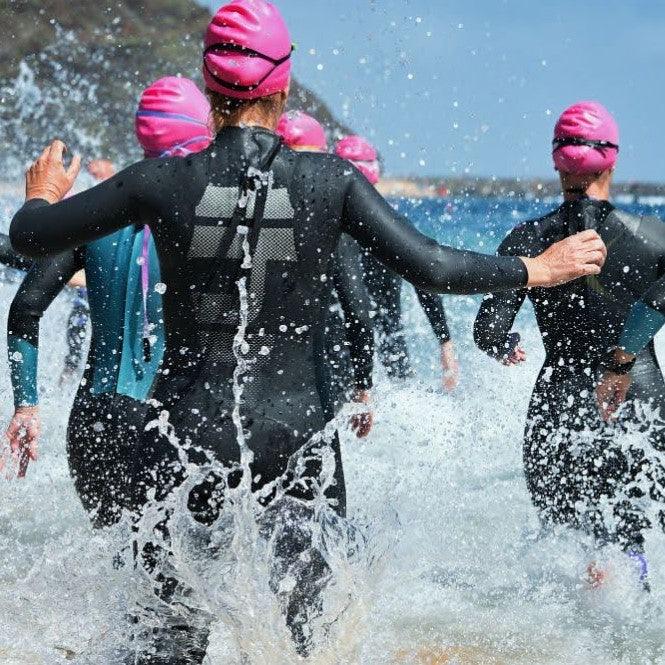Open Water Swim Essentials

Taking that first plunge into open water swimming can be an intimidating launch. No lane lines. Can’t see the bottom. Was that a fish? Man, that’s cold! After the initial shock you may find you prefer swimming in open water more than the pool! You have swimming freedom, no lane sharing and sunshine feels great! What does it take to make the most of your open water swim, and how can you do it safely?
Open Water Swim Safety:
Number one rule, don’t swim alone. At minimum have a friend on land that knows what you’re doing. Otherwise, it’s hard to get help if nobody knows where you are.
Consider swimming parallel to shore. On a public beach? Stick near the buoy line. You will have a clear idea of where to swim and can touch your toes easily.
Invest is a swim buoy or tow float. They are inflatable brightly colored VISABLE bags attached to a cord, attached to a waist belt that minimally drags behind you in the water. Should you cramp or need a break, simply grab your float and rest. Try it as a water pillow! Back float and enjoy the scenery! Many tow floats are also waterproof bags. Keep your essentials with you while swimming and use it as a dry bag to stow car keys or a phone.
Never swim on a motorized lake unless you have a support craft (canoe, kayak, boat) along with you. Fish are not your concern; motorboats are a real threat to your safety. Speed boats and jet skis simply will not see your tiny tow float in time. Be visible and know your lake.
Items needed to open water swim?
- Tow float/swim buoy - is your number one item.
- Swim goggles - are number two. Wearing swim goggles will not magically help you see the bottom of a murky lake, but they will make ‘sighting’, using an object on the shore to guide your swim. (such as a beach, tree, or building) easier. Swim goggles are offered in different tints. Choosing your vision color depends on the time of day you swim and colors you want to see. An early morning swimmer facing low sun in your eyes? Try a tinted or reflective pair. Are you a noon swimmer? You may need googles with just a hint of color, like blue, to help you better see that bright lifeguard chair.
- Swim Cap - Do not forget a Swim cap. A brightly colored cap also increases your visibility by others, keeps your hair in place and adds a bit of warmth.
- Wetsuit - Is the water cold? Are you planning to compete in an open water swim event or triathlon? Either way, you will need a wetsuit. Swim wetsuits are different from waterski / surfing suits which are more abrasion proof and heavier. Tri wet suits are made of neoprene w/o the protective covering, so they are lighter, faster, more flexible, and less durable.
- A Towel – One thing I always forget. speaking from personal experience, I’ll pack everything I need for a swim, change into my wetsuit, enjoy the lake, get back to shore and realize I am wet and chilly. I’ve driven home more times than I’d like to admit wearing wet clothes.

Benefits to wearing a wetsuit for open water swims:
Buoyancy. Wetsuits allow you to float higher in the water, especially your legs, helping you swim easier and therefore faster! A long-sleeved wetsuit will provide the most buoyancy. Pricier wetsuits are designed with varying neoprene thicknesses; thinner and softer in the shoulders and arms for greater flexibility and swim catch, and thicker in the legs for floatation. However, many triathletes feel more comfortable with a sleeveless suit. There is less shoulder restriction in a short-sleeved wetsuit, and they are cooler when swimming in warm lakes, but a full sleeve suit is always faster. Shorties (wet suits stopping above the knees) are not serious tri suits.
Warmth. Wetsuits make swimming in most water conditions more pleasant. Thermal swim caps and booties are optional accessories for combatting cold water. (and of course, peeing in your wetsuit …. helps)
Security. Neoprene protects you from seaweed fears. And fish fears. Donning a wetsuit acts like a little swim cocoon making an outdoor lake like a welcoming bathtub.
Anti-chaffing products. Body Glide and Sports Shield are two helpful products to prevent chaffing in a wetsuit, or swimsuit, or on a bike or run. Apply them to all the skin places where fabrics may rub. A super simple useful item.
Hope this information helps you get out and enjoy the water! Open water swimming is a fantastic way to change up your swim days, enjoy the sunshine, and can expand your swimming experiences.
Have fun and stay safe.
- Ben Harding
Gear West Videos
How to Stop on rollerskis


